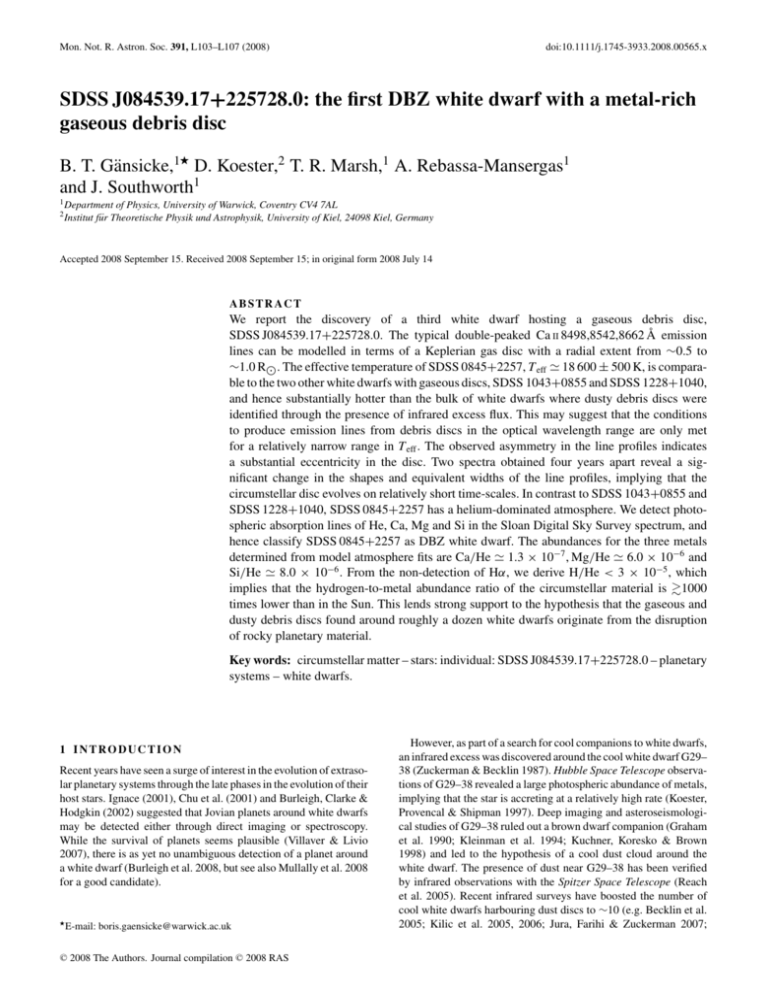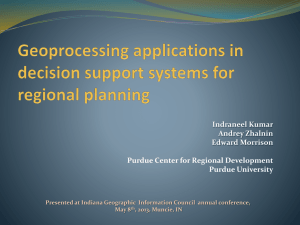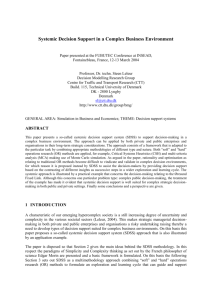the first DBZ white dwarf with a metal
advertisement

Mon. Not. R. Astron. Soc. 391, L103–L107 (2008) doi:10.1111/j.1745-3933.2008.00565.x SDSS J084539.17+225728.0: the first DBZ white dwarf with a metal-rich gaseous debris disc B. T. Gänsicke,1 D. Koester,2 T. R. Marsh,1 A. Rebassa-Mansergas1 and J. Southworth1 1 Department 2 Institut of Physics, University of Warwick, Coventry CV4 7AL für Theoretische Physik und Astrophysik, University of Kiel, 24098 Kiel, Germany Accepted 2008 September 15. Received 2008 September 15; in original form 2008 July 14 ABSTRACT We report the discovery of a third white dwarf hosting a gaseous debris disc, SDSS J084539.17+225728.0. The typical double-peaked Ca II 8498,8542,8662 Å emission lines can be modelled in terms of a Keplerian gas disc with a radial extent from ∼0.5 to ∼1.0 R . The effective temperature of SDSS 0845+2257, T eff 18 600 ± 500 K, is comparable to the two other white dwarfs with gaseous discs, SDSS 1043+0855 and SDSS 1228+1040, and hence substantially hotter than the bulk of white dwarfs where dusty debris discs were identified through the presence of infrared excess flux. This may suggest that the conditions to produce emission lines from debris discs in the optical wavelength range are only met for a relatively narrow range in T eff . The observed asymmetry in the line profiles indicates a substantial eccentricity in the disc. Two spectra obtained four years apart reveal a significant change in the shapes and equivalent widths of the line profiles, implying that the circumstellar disc evolves on relatively short time-scales. In contrast to SDSS 1043+0855 and SDSS 1228+1040, SDSS 0845+2257 has a helium-dominated atmosphere. We detect photospheric absorption lines of He, Ca, Mg and Si in the Sloan Digital Sky Survey spectrum, and hence classify SDSS 0845+2257 as DBZ white dwarf. The abundances for the three metals determined from model atmosphere fits are Ca/He 1.3 × 10−7 , Mg/He 6.0 × 10−6 and Si/He 8.0 × 10−6 . From the non-detection of Hα, we derive H/He < 3 × 10−5 , which implies that the hydrogen-to-metal abundance ratio of the circumstellar material is 1000 times lower than in the Sun. This lends strong support to the hypothesis that the gaseous and dusty debris discs found around roughly a dozen white dwarfs originate from the disruption of rocky planetary material. Key words: circumstellar matter – stars: individual: SDSS J084539.17+225728.0 – planetary systems – white dwarfs. 1 I N T RO D U C T I O N Recent years have seen a surge of interest in the evolution of extrasolar planetary systems through the late phases in the evolution of their host stars. Ignace (2001), Chu et al. (2001) and Burleigh, Clarke & Hodgkin (2002) suggested that Jovian planets around white dwarfs may be detected either through direct imaging or spectroscopy. While the survival of planets seems plausible (Villaver & Livio 2007), there is as yet no unambiguous detection of a planet around a white dwarf (Burleigh et al. 2008, but see also Mullally et al. 2008 for a good candidate). E-mail: boris.gaensicke@warwick.ac.uk C C 2008 RAS 2008 The Authors. Journal compilation However, as part of a search for cool companions to white dwarfs, an infrared excess was discovered around the cool white dwarf G29– 38 (Zuckerman & Becklin 1987). Hubble Space Telescope observations of G29–38 revealed a large photospheric abundance of metals, implying that the star is accreting at a relatively high rate (Koester, Provencal & Shipman 1997). Deep imaging and asteroseismological studies of G29–38 ruled out a brown dwarf companion (Graham et al. 1990; Kleinman et al. 1994; Kuchner, Koresko & Brown 1998) and led to the hypothesis of a cool dust cloud around the white dwarf. The presence of dust near G29–38 has been verified by infrared observations with the Spitzer Space Telescope (Reach et al. 2005). Recent infrared surveys have boosted the number of cool white dwarfs harbouring dust discs to ∼10 (e.g. Becklin et al. 2005; Kilic et al. 2005, 2006; Jura, Farihi & Zuckerman 2007; L104 B. T. Gänsicke et al. Kilic & Redfield 2007; von Hippel et al. 2007; Farihi, Zuckerman & Becklin 2008). These dust discs originate from the tidal disruption of either comets (Debes & Sigurdsson 2002) or asteroids (Jura 2003). Asteroids appear to be more likely as they can explain the large metal abundances in the material accreted by the white dwarfs from the dusty environment. Hydrogen-rich white dwarfs with radiative atmospheres (T eff 11 500 K) have short diffusion time-scales for heavy elements, and hence their photospheric abundances should closely reflect the chemical abundances of the circumstellar debris discs from which they are accreting. Zuckerman et al. (2007) suggested that such systems offer potential insight into the chemical composition of extrasolar planetary systems, once more detailed calculations of diffusion time-scales for a wide range of elements and atmospheric parameters are available. We have recently identified two hydrogen-dominated (DA) white dwarfs, SDSS J122859.93+104032.9 and SDSS J104341.53+ 085558.2 (henceforth SDSS 1228+1040 and SDSS 1043+0855), which exhibit double-peaked emission lines in the I-band Ca II triplet (Gänsicke et al. 2006; Gänsicke, Marsh & Southworth 2007). From the morphology of the Ca II lines profiles, we inferred the presence of gaseous circumstellar discs close (∼R ) to the white dwarfs. Like the majority of the white dwarfs with dusty debris discs, both SDSS 1228+1040 and SDSS 1043+0855 have hydrogen-rich metal-polluted (DAZ) atmospheres, indicating that they are accreting from the circumstellar material. The absence of photospheric helium absorption lines, as well as of Balmer emission lines from the gaseous discs, strongly suggests that circumstellar material around SDSS 1228+1040 and SDSS 1043+0855 is depleted in volatile elements. A dusty extension to the gaseous disc in SDSS 1228+1040 has been detected with Spitzer (Brinkworth et al. 2008). Here, we present a third white dwarf with a metal-rich gaseous debris disc, the helium-dominated (DB) SDSS J084539.17+225728.0 (henceforth SDSS 0845+2257). 2 S D S S A N D W H T O B S E RVAT I O N S O F S D S S 0 8 4 5 +2 2 5 7 We selected 15 116 unique spectroscopic objects from Data Release 6 of the Sloan Digital Sky Survey (SDSS DR 6, AdelmanMcCarthy et al. 2008) that were classified by the SDSS spectroscopic reduction pipeline as stars, and are bluer than the main sequence (u − g < 0.8) with relatively low uncertainties in their i-band photometry (σ i < 0.1 mag). The spectra of these objects were subjected to an automatic measurement of the equivalent width of the Ca II 8498,8542,8662 Å triplet (see Gänsicke et al. 2007, for details). This search resulted in a list of 484 candidates exhibiting a 3σ excess in the Ca II triplet over the neighbouring continuum, which were then visually inspected. The vast majority of the spectra flagged by our program are affected by poor night sky line subtraction.1 Among the 484 candidates, we identified 82 cataclysmic variables (CVs) 1 Sky background subtraction in fibre spectroscopy, such as carried out by SDSS, is notoriously more difficult than in slit spectroscopy as (i) the fibres typically have a larger on-sky area (3 arcsec in the case of SDSS) than a slit, resulting in a larger contamination by sky background and (ii) the sky subtraction is done via dedicated sky fibres that are placed some distance away from the target fibre, which can result in different optical paths, spectroscopic responses, etc. In addition, any small offset in wavelength between the sky spectrum and object spectrum will result in large residuals near strong sky lines. C Figure 1. Comparison of the Ca II 8498,8542,8662 Å emission lines in the SDSS spectra of the three white dwarfs SDSS 1228+1040 (top panel, Gänsicke et al. 2006), SDSS 0845+0855 (middle panel) and SDSS 1043+0855 (bottom panel, Gänsicke et al. 2007). The spectra of SDSS 0845+0855 and SDSS 1228+1040 are offset by one and two units, respectively. exhibiting Ca II emission, most of which were previously discovered (Szkody et al. 2007, and references therein). The spectra of all those CVs contain strong and broad Balmer emission lines, and in most cases notable He emission lines as well. Only three apparently single white dwarfs with unambiguous emission in all three components of the Ca II triplet were found (Fig. 1): the two previously known DA white dwarfs with gaseous debris discs, SDSS 1228+1040 and SDSS 1043+0855, and the first DB white dwarf displaying Ca II emission, SDSS 0845+2257 (Fig. 2). SDSS 0845+2257 has been previously identified as an ultraviolet-excess source (PG 0842+231, Ton 345) and classified as an sdO subdwarf (Green, Schmidt & Liebert 1986). The absence of close companion to these three white dwarfs is suggested by the complete lack of either Balmer or He emission lines in their optical spectra. The single white dwarf nature of SDSS 1228+1040 was corroborated by extensive time-resolved spectroscopy and photometry, which ruled out the presence of short-period radial velocity variations and brightness modulations (Gänsicke et al. 2006). By analogy to SDSS 1228+1040, we infer that SDSS 0845+2257 is also a single white dwarf harbouring a metal-rich gaseous accretion disc fed from circumstellar debris. The double-peaked Ca II profiles in SDSS 0845+2257 display a strong asymmetry (Fig. 1), suggesting a stronger ellipticity and/or azimuthal brightness variation of the gaseous ring than in the other two systems. Closer inspection of the SDSS spectrum also revealed weak emission of Fe II 5169 Å, as well as narrow, weak absorption C 2008 RAS, MNRAS 391, L103–L107 2008 The Authors. Journal compilation A DBZ white dwarf with a gaseous debris disc L105 Figure 2. Model atmosphere fit to the spectrum of SDSS 0845+2257. Main panel: best fit to the SDSS spectrum with T eff = 18 621 K and log g = 8.175. The positions of the Ca II and Fe II emission lines are indicated. Top panels: close-ups of the average WHT spectrum regions featuring photospheric metal absorption lines of Ca, Mg and Si. The model shown has been computed for the following abundances: Ca/He 1.3 × 10−7 , Mg/He 6.0 × 10−6 and Si/He 8.0 × 10−6 . The non-detection of Hα absorption implies H/He < 3 × 10−5 . lines of Ca, Si and Mg originating in the helium-dominated atmosphere of the white dwarf. Intermediate-resolution spectroscopy of SDSS 0845+2257 was obtained on 2008 January 2 using the double-arm spectrograph ISIS on the William Herschel Telescope (WHT). In the blue arm, we used the R600B grating and a 4 × 2 k pixel EEV detector; and in the red arm, the R316R grating and a low-fringing 4 × 2 k pixel REDPLUS detector. This setup provided a wavelength coverage of 3600–5100 Å at a resolution of 1.8 Å and 6100–8800 Å at a resolution of 3.3 Å. Two pairs of blue/red spectra with individual exposure times of 15 min were obtained under average atmospheric conditions, i.e. thin cirrus and ∼1.2 arcsec seeing. The data were reduced following the methods described in Southworth et al. (2007). The WHT spectra confirmed the presence of photospheric Ca, Si and Mg absorption lines, and, more importantly, reveal a significant change in the shape and strength of the Ca II triplet with respect to the SDSS spectrum. Fig. 3 compares the SDSS and the WHT spectra, and also indicates the wavelengths of strong night sky lines. It Figure 3. Comparison of the Ca II 8498,8542,8662 Å emission lines of SDSS 0845+2257 in the SDSS spectrum obtained in 2004 December (left-hand panel) and in our WHT spectrum from 2008 January (right-hand panel). The data are shown as grey histogram with error bars. Besides a clear change in the morphology of the line profiles, the equivalent width decreased from 20 ± 1 Å in 2004 to 13 ± 0.5 Å in 2008. Superimposed as thick black lines are the best-fit dynamical disc models for the two epochs (Section 4). The model for the 2004 SDSS spectrum is repeated in the plot of the WHT as thin dashed line to illustrate the changes in the line shapes and strengths. Finally, the thin solid lines at the bottom of the panels indicate the positions of strong night sky lines. C C 2008 RAS, MNRAS 391, L103–L107 2008 The Authors. Journal compilation L106 B. T. Gänsicke et al. is clear that the observed change in the Ca II line profiles is intrinsic to SDSS 0845+2257, and not caused by differences in the sky subtraction between the SDSS and WHT spectra. 3 M O D E L AT M O S P H E R E A N A LY S I S We fitted the SDSS spectrum of SDSS 0845+2257 following the methods outlined in Voss et al. (2007) using synthetic spectra calculated with the model atmosphere code described by Finley, Koester & Basri (1997); Koester & Wolff (2000) and Koester et al. (2005). Using pure He atmosphere models, the best fit is achieved for T eff = 18 621 ± 60 K and log g = 8.175 ± 0.023. In a second step, we have investigated the abundances of H, Ca, Mg and Si. From the absence of Hα absorption, we determine H/He < 3 × 10−5 . A model calculated with Ca/He 1.3 × 10−7 , Mg/He 6.0 × 10−6 and Si/He 8.0 × 10−6 provides an acceptable fit of the observed photospheric absorption, with an estimated uncertainty of a factor of 2 in the abundances. A more detailed analysis will have to await data of higher spectral resolution and signal-to-noise ratio, and if possible extension of the spectroscopic observations into the ultraviolet which contains thousands of lines of a large number of chemical elements. Adopting a hydrogen abundance of H/He = 10−5 results only in modest changes in the best-fitting effective temperature and surface gravity, T eff = 18 525 ± 60 K and log g = 8.281 ± 0.022. The quoted errors are of purely statistical nature, and should be regarded as a strict lower limit. Based on our experience, we suggest that realistic errors are 500 K for T eff and 0.2 dex for log g. Using Wood’s (1995) mass–radius relation and cooling models, we find a mass of 0.7 M and a cooling age of 150 Myr. 4 T H E S T RU C T U R E O F T H E G A S E O U S R I N G The double-peaked Ca II emission lines changed significantly both in morphology and equivalent width between the SDSS spectrum taken in 2004 December, and our WHT spectrum taken in 2008 January (Fig. 3). These changes clearly demonstrate that the circumstellar material is undergoing some kind of evolution on time-scales as short as years. We have modelled both sets of observed Ca II emission-line profiles (Fig. 3) following the prescription outlined in Gänsicke et al. (2006). In brief, the disc is represented by a set of co-aligned elliptical orbits of constant eccentricity. The emissivity varies as a power law in radius and varies azimuthally as a sinusoid with maximum and minimum flux along the semimajor axis. The only difference from Gänsicke et al. (2006) is that we automated the optimization of the model to minimize χ 2 . The SDSS spectrum can be modelled by emission from a disc with an inner and outer radius of ≈0.3 and ≈0.9 R , with an eccentricity of ≈0.4. The WHT spectrum is best fit by a disc with an inner radius of ≈0.5 and ≈0.8 R , with an eccentricity of ≈0.2. Our model suffers from degeneracies between different parameters, and consequently these numbers should be considered as guidance, rather than exact results. However, the following conclusions appear to be firm. SDSS 0845+2257 hosts an eccentric circumstellar disc of metalrich gas with Ca II emission originating over a radial extent of ∼0.5 to ∼1.0 R . While the radial extension of the Ca II gas is similar to that found in SDSS 1228+1040 (Gänsicke et al. 2006), the eccentricity of the disc in SDSS 0845+2257 is substantially larger. We have initiated a spectroscopic monitoring of SDSS 1228+1040 and SDSS 0845+2257 that will hopefully provide more insight into the dynamical evolution of their circumstellar discs. C 5 T H E N AT U R E O F T H E C I R C U M S T E L L A R M AT E R I A L The origin of metals in the atmospheres of cool white dwarfs has been subject to a long debate, with accretion from the interstellar medium (ISM) (e.g. Dupuis, Fontaine & Wesemael 1993) having been the most widely accepted scenario until recently. The discovery of circumstellar dust discs around a number of white dwarfs with metal-polluted atmospheres (e.g. Becklin et al. 2005; Kilic et al. 2005; Farihi et al. 2008) lead to the suggestion that accretion of comets (Debes & Sigurdsson 2002) or asteroids (Jura 2003) may contribute to the pollution of white dwarfs with heavy elements. In the case of DAZ white dwarfs, which have hydrogendominated atmospheres, the relative abundances of hydrogen and metals within the accreted material are difficult to gauge. In contrast to this, metal-polluted white dwarfs with helium-rich atmospheres allow much tighter constraints on the hydrogen abundance of the accreted material. Dupuis et al. (1993) and Friedrich et al. (1999) showed for the DBZ white dwarfs GD 40 and HS 2253+8023 that whereas the metal-to-metal abundance ratios were consistent with accretion from the ISM, the hydrogen-to-metal abundance ratio has to be 104 –106 lower than typical ISM abundances to be consistent with the observed spectra of the two DBZ white dwarfs. In a later paper, Friedrich, Jordan & Koester (2004) ruled out that a weak magnetic field acting as a propeller might suppress the accretion of hydrogen in GD 40. Recently, Jura et al. (2007) detected infrared excess around GD 40 which strongly supports the hypothesis that the metals in the atmosphere of the white dwarf are related to ongoing accretion from a disc of hydrogen-depleted dust. Jura (2006) took the argument of accretion of asteroid debris in GD 40 a step further, suggesting that the apparent carbon-to-iron deficiency in the atmosphere of the star is similar to the abundance pattern of chondritic asteroids. Besides GD 40, SDSS 0845+2257 is only the second bona fide DBZ white dwarf in which a circumstellar disc has been detected. Our current observations constrain the metal-to-hydrogen abundance ratio of the accreted material to be 103 – 104 times larger than observed in the Sun, which strongly supports Jura’s (2003) scenario of metal pollution by ongoing accretion from tidally disrupted asteroids. While DB white dwarfs allow tight constraints on the hydrogen fraction in the accreted material, the sedimentation times for metals are many orders of magnitude larger than in DA white dwarfs (Paquette et al. 1986; Koester & Wilken (2006); e.g. ∼105 yr for SDSS 0845+2257 versus d in SDSS 1228+1040), and may differ by factors of a few for different chemical species. In order to reach an accretion/diffusion steady state, the white dwarf has to accrete at a constant rate for two to three times the diffusion time-scale, i.e. close to 106 yr in the case of SDSS 0845+2257. It seems unlikely that an asteroid debris disc can sustain a constant mass-loss rate for such a long period of time. In the case of time-dependent accretion rates, the observed metal-to-metal abundance ratios will be variable. Dupuis et al. (1993) presented a time-dependent model of accretion on to white dwarfs, adopting a variation in accretion rate by a factor of 105 , and found that observed Mg/Ca, Si/Ca and Fe/Ca metal-to-metal ratios could differ by up to a factor of 100, depending on the timing of the observations with respect to the change in accretion rate. We conclude that, given the long diffusion time-scales, the metal-to-metal abundance ratios seen in a DBZ atmosphere are unlikely to be an immediate proxy for the chemical abundances of the circumstellar material. C 2008 RAS, MNRAS 391, L103–L107 2008 The Authors. Journal compilation A DBZ white dwarf with a gaseous debris disc L107 6 CONCLUSIONS REFERENCES We have identified SDSS 0845+2257 as the third white dwarf known to host a metal-rich gaseous circumstellar disc. SDSS 0845+2257 has a similar temperature as SDSS 1043+0855 and SDSS 1228+1040, and all three are substantially hotter (T eff ∼ 20 000 K) compared to the majority of the white dwarfs with dusty discs identified in surveys for infrared excess fluxes. The total roster of white dwarfs with gaseous and/or dusty debris discs stands at 13, of which ∼25 per cent were identified through the presence of Ca II emission lines in their SDSS spectra. Taking the masses of the three white dwarfs with gaseous debris discs at face value, we find M wd = 0.73 ± 0.07 M , which is marginally higher than the mean mass of field white dwarfs (Liebert, Bergeron & Holberg 2005). A speculative line of thought is that the potentially higher occurence of debris discs around more massive white dwarfs is related to the higher frequency of debris discs around A-stars compared to Sun-like stars (Su et al. 2006; Trilling et al. 2008). In contrast to SDSS 1228+1040 and SDSS 1043+0857, SDSS 0845+2257 has a helium-dominated atmosphere and the detection of Ca, Mg, and Si absorption lines qualifies it as a DBZ white dwarf. The presence of a circumstellar disc strongly suggests that ongoing accretion is the origin of the observed photospheric metals. The non-detection of Hα absorption in the SDSS spectrum of SDSS 0845+2257 implies that the hydrogen-to-metal ratio in the circumstellar material is at least a factor of 1000 smaller than the solar value (Dupuis et al. 1993; Friedrich et al. 1999). The most likely origin of the metal-rich material is planetary debris, such as the tidal disruption of a rocky asteroid (Jura 2003). Modelling the broad double-peaked Ca II emission lines observed in SDSS 0845+2257 with a Keplerian gas disc confines the region of the Ca II emission to a radial extension of ∼0.5 to ∼1.0 R . The line profiles display a large asymmetry, which we interpret as a significant asymmetry in the gaseous disc. The line profile shapes and equivalent widths of the Ca II emission lines varied substantially in between two observations taken ∼4 yr apart. Following the detection of variability in the equivalent widths of the photospheric Ca H&K absorption lines seen in G29–38 (von Hippel & Thompson 2007), this is the second piece of evidence indicating that the structure of circumstellar debris around white dwarfs undergo changes on relatively short time-scales. Jura (2008) suggested that rather than a single tidal disruption event, white dwarfs with remnants of planetary systems may experience repeated accretion of small asteroids. Such recurrent events may potentially be related to variability such as observed in SDSS 0845+2257. Whatever the cause of the changes in the Ca II emission lines, longterm monitoring of SDSS 0845+2257 is likely to offer direct dynamical insight into the evolution of debris discs around white dwarfs. Adelman-McCarthy J. K. et al., 2008, ApJS, 175, 297 Becklin E. E., Farihi J., Jura M., Song I., Weinberger A. J., Zuckerman B., 2005, ApJ Lett., 632, L119 Brinkworth C., Gänsicke B., Marsh T. R., Hoard D. W., Tappert C., 2008, ApJ, submitted Burleigh M. R., Clarke F. J., Hodgkin S. T., 2002, MNRAS, 331, L41 Burleigh M. R. et al., 2008, MNRAS, 386, L5 Chu Y.-H., Dunne B. C., Gruendl R. A., Brandner W., 2001, ApJ Lett., 546, L61 Debes J. H., Sigurdsson S., 2002, ApJ, 572, 556 Dupuis J., Fontaine G., Wesemael F., 1993, ApJS, 87, 345 Farihi J., Zuckerman B., Becklin E. E., 2008, ApJ, 674, 431 Finley D. S., Koester D., Basri G., 1997, ApJ, 488, 375 Friedrich S., Koester D., Heber U., Jeffery C. S., Reimers D., 1999, A&A, 350, 865 Friedrich S., Jordan S., Koester D., 2004, A&A, 424, 665 Gänsicke B. T., Marsh T. R., Southworth J., Rebassa-Mansergas A., 2006, Sci, 314, 1908 Gänsicke B. T., Marsh T. R., Southworth J., 2007, MNRAS, 380, L35 Graham J. R., Matthews K., Neugebauer G., Soifer B. T., 1990, ApJ, 357, 216 Green R. F., Schmidt M., Liebert J., 1986, ApJS, 61, 305 Ignace R., 2001, PASP, 113, 1227 Jura M., 2003, ApJ Lett., 584, L91 Jura M., 2006, ApJ, 653, 613 Jura M., 2008, AJ, 135, 1785 Jura M., Farihi J., Zuckerman B., 2007, ApJ, 663, 1285 Kilic M., Redfield S., 2007, ApJ, 660, 641 Kilic M., von Hippel T., Leggett S. K., Winget D. E., 2005, ApJ, 632, L115 Kilic M., von Hippel T., Leggett S. K., Winget D. E., 2006, ApJ, 646, 474 Kleinman S. J. et al., 1994, ApJ, 436, 875 Koester D., Wilken D., 2006, A&A, 453, 1051 Koester D., Wolff B., 2000, A&A, 357, 587 Koester D., Provencal J., Shipman H. L., 1997, A&A, 320, L57 Koester D., Napiwotzki R., Voss B., Homeier D., Reimers D., 2005, A&A, 439, 317 Kuchner M. J., Koresko C. D., Brown M. E., 1998, ApJ Lett., 508, L81 Liebert J., Bergeron P., Holberg J. B., 2005, ApJS, 156, 47 Mullally F., Winget D. E., Degennaro S., Jeffery E., Thompson S. E., Chandler D., Kepler S. O., 2008, ApJ, 676, 573 Paquette C., Pelletier C., Fontaine G., Michaud G., 1986, ApJS, 61, 177 Reach W. T., Kuchner M. J., von Hippel T., Burrows A., Mullally F., Kilic M., Winget D. E., 2005, ApJ Lett., 635, L161 Southworth J., Marsh T. R., Gänsicke B. T., Aungwerojwit A., Hakala P., de Martino D., Lehto H., 2007, MNRAS, 382, 1145 Su K. Y. L. et al., 2006, ApJ, 653, 675 Szkody P. et al., 2007, AJ, 134, 185 Trilling D. E. et al., 2008, ApJ, 674, 1086 Villaver E., Livio M., 2007, ApJ, 661, 1192 von Hippel T., Thompson S. E., 2007, ApJ, 661, 477 von Hippel T., Kuchner M. J., Kilic M., Mullally F., Reach W. T., 2007, ApJ, 662, 544 Voss B., Koester D., Napiwotzki R., Christlieb N., Reimers D., 2007, A&A, 470, 1079 Wood M. A., 1995, in Koester, D., Werner, K., eds, White Dwarfs, no. 443 in LNP, Springer, Heidelberg, p. 41 Zuckerman B., Becklin E. E., 1987, Nat, 330, 138 Zuckerman B., Koester D., Melis C., Hansen B. M., Jura M., 2007, ApJ, 671, 872 AC K N OW L E D G M E N T S Funding for the Sloan Digital Sky Survey (SDSS) and SDSS-II has been provided by the Alfred P. Sloan Foundation, the Participating Institutions, the National Science Foundation, the US Department of Energy, the National Aeronautics and Space Administration, the Japanese Monbukagakusho, and the Max Planck Society and the Higher Education Funding Council for England. The SDSS web site is http://www.sdss.org/. We thank the referee, Mukremin Kilic, for his quick and constructive report. C This paper has been typeset from a TEX/LATEX file prepared by the author. C 2008 RAS, MNRAS 391, L103–L107 2008 The Authors. Journal compilation









